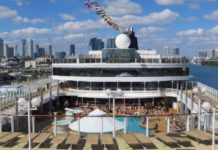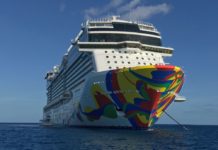Perhaps no industry has been as tied to the negative aspects of the health crisis than cruising. But could your next cruise actually be safer than being in your own hometown? It’s been the stated goal of cruise line executives, and there is reason to think it may not be that far off.
“We really do believe that it is possible to make it so that you are safer on a cruise ship than you are on main street,” Royal Caribbean Group CEO Richard Fain recently said.

At the start of the pandemic, some of the outbreaks with the most headlines were aboard cruise ships.
The world watched as ships had to hold offshore, being denied entry to ports. Then there were some ships where passengers were quarantined at the dock, as virus cases rose among those onboard.
In the early days of the pandemic, it seemed as if cruises were a magnet for new cases. This lead to outsized media coverage, with headlines that slammed cruise lines.
Not long after the pandemic showed signs of spreading worldwide, the industry as a whole paused operations in mid-March. The Centers for Disease Control (CDC) also issued a “No Sail Order” that kept lines from sailing in the United States.
This was a bold move to stem the number of cases on ships. Even so, the link between cruise ships and COVID had already been made in many people’s minds.
Putting Cruise Ship Virus Numbers in Perspective

Before seeing how taking a cruise could possibly be safer than being out and about in your city, it’s helpful to understand the number of cases tied to cruising.
The Miami Herald compiled data for the number of cases tied to ocean-going cruise ships. According to their count, there have been approximately 3,900 cases and 111 deaths tied to cruise ships around the world.
There are some caveats to those numbers.
First, ships did stop sailing in mid-March, drastically reducing the potential for more cases because of fewer passengers. As well, early in the crisis testing around the world was not near at the level it is today. It’s possible that cases were missed both on ships and elsewhere.
Even so, comparing those numbers to what’s been seen since shows that while cruises were given sensational headlines, the cases were relatively low. To date, there have been about 55 million cases confirmed around the world, with the United States having more than 11 million of those.
Dade County, Florida alone — home to the world’s busiest cruise port — has seen more than 200,000 cases. That’s more than 50 times what’s been seen on cruise ships around the world.
This simply shows that while yes, cruise ships had their cases, this pandemic has spread seemingly everywhere. No matter where you live, you’ve been in an environment where COVID has had an impact.
That said, the CDC points out that cruise ships can be conducive to spread. They mention a reproduction rate of 14.8 aboard Diamond Princess before a quarantine was put in place. That means one sick person spread the illness to nearly 15 others. That’s about four times the rate seen in Wuhan, China.
Reducing Illness — Not Eliminating It
With the continued spread of the virus, there seems to have been a change in thinking on how to proceed during the pandemic. Whereas lockdowns were popular choices at first, as time has gone on many have looked to ways to manage the risk of getting sick instead of completely eliminating it.
This risk management has led to steps like mask-wearing, restaurants offering outdoor seating, and limited capacity in many venues. It’s even led to “bubbles” like those seen with sports leagues such as the NBA where groups of people can come together in relative safety.
In other words, as the health crisis has continued, the thinking seems to have changed from how to completely eliminate any chance of getting sick to how to make doing the things we need or want to do as safe as possible.
And in the case of cruise lines, that seems to be exactly what they are aiming for — making cruising as safe as possible. So safe, in fact, that it’s safer than being out and about in your hometown.
In fact, cruise line executives freely admit that, yes, there will be cases on cruise ships as there are cases everywhere. But the goal is to make the ship as safe — or safer — than any other public place.
Given the negative headlines about cruising and COVID at the start of the pandemic, how can a ship possibly be safer than your hometown?
Cruise Line Health & Safety Plans

To say that cruise lines are transforming cruising in the face of the pandemic would be an understatement. Since even before the industry paused, lines have taken steps to make their ships safer.
The biggest step in the industry since pausing has arguably been the creation of the Healthy Sail Panel. This panel was created in a joint venture between Royal Caribbean Group and Norwegian Cruise Line Holdings. It was formed to explore how to make cruising more healthy in the face of the pandemic — and then share those results with everyone in the industry.
Numerous experts makes up the panel. This includes the former Governor of Utah and Secretary of Health and Human Services, Michael Leavitt and Dr. Scott Gottlieb, the former Commissioner of the Food and Drug Administration.
The Healthy Sail Panel worked for months to come up with plans to transform the way cruises operate in the face of this virus. The result was 74 recommendations that apply to all areas of cruising. It includes everything from facemasks to limited capacity on ships, improved medical facilities, what to do if there is a case on the ship, and even how to get passengers home.
This plan represents the cornerstone of what cruise lines plan to do to keep passengers healthy while on vacation, and how cruise lines aim to make sailing safer than ever before.
Meanwhile, the CDC framework announced in late October also lays out a series of steps that cruise lines must take to sail again, with heavy oversight by the agency.
Among the changes to cruising:
100% Testing of Passengers and Crew
Perhaps the biggest step cruise lines are taking is requiring 100% testing of everyone boarding the ship before they can sail. The CDC is going a step farther in requiring a test on the day of embarkation before boarding. Being surrounded by others who have all tested negative is a major step in improving the safety of cruising.
“We believe there are things that make ships more demanding in terms of what you might want to take, but there’s also the advantage that a ship has,” said Royal Caribbean’s Fain. “And the biggest advantage is that we have a controlled environment.”
“A big part of that is to create this kind of bubble in the beginning to do screening. No other industry that I know of has agreed to do 100% screening of everyone. And I think that’s a big part of what makes this a viable project.”
Improved Air Filtration
There is evidence that air conditioning systems can help spread the virus through the air, even if you are distanced from others. To combat this, cruise lines are dramatically upgrading their air conditioning systems. This includes more efficient filtration, as well as taking in outside air in many cases, instead of simply re-circulating indoor air.
Limited Capacity & Social Distancing
Of course the more people on a ship, the harder it is to maintain distance. That’s why cruises will return with limited capacity. The numbers mentioned by cruise lines are roughly 50% of full capacity.
With fewer passengers, it will also be easier to implement new social distancing requirements in places like the casino, theaters, restaurants, and pool decks. Expect less seating available, dividers, and other methods to ensure people keep a healthy distance.
Shore Excursion Bubble
It doesn’t make much sense to test all passengers, have them follow all the carefully-applied rules, only to let them have free reign to head into port and possibly interact with an infected person.
That’s why shore excursion “bubbles” are set to be put in place. Here, passengers will head out on approved excursions where health and safety rules are known to be followed. As well, cruise line private islands — where they have full control over the activities on shore — are also set to play a major role.
Policies If There Is A Case Onboard
The cruise lines and CDC aren’t just interested in how to keep cases from getting on the ship. What happens when cases inevitably do find their way onto a cruise ship?
The CDC is implementing policies where cruise lines will have to end a cruise immediately if a “threshold” of cases are found. As well, plans will be in place to isolate infected passengers and quarantine others.
Finally, cruise lines must have plans in place to transport passengers home using non-commercial transportation so that those who have possibly been exposed aren’t mingling with the public to get home.

All told, these are just a handful of the new ways cruise lines are changing to address the virus. Combined, the steps create a multi-layered plan to prevent cases and then contain the illness should something happen.
That’s much more than can be said for what is happening on land.
For example, say someone tests positive for COVID in your city. There is very little that keeps them from continuing to go about their daily activities. They are still free to go out and about if they need to do so, although hopefully they would not.
What’s more is that many people in your town may be positive for the virus and asymptomatic. Or someone could think they have a cold or allergies but instead have the virus. That means they could be spreading it unknowingly.
Put simply, people aren’t getting tested before they go inside a grocery store or to the gym back home.
With universal testing and other methods, cruise lines are able to take dramatic steps and keep control of the environment. Of course, no measure will be 100% perfect. But with these steps, it could turn a ship from one of the most conducive places to spread a virus into one that’s potentially even safer than being in your hometown.
Results of New Protocols So Far
The results of new measures so far have been positive, but not perfect.
In Europe, where several lines have returned to sailing, tens of thousands of passengers have taken to sea with success.
And despite Germany, France, and Italy all seeing recent spikes that are higher than what was seen in March during the region’s first peak, cruises in the region seem to have relatively few cases at this point.
For instance, one ship sailing Europe — Costa Diadema — reportedly had eight cases tied to it.
As well, a small ship sailing the Caribbean from Barbados (which doesn’t fall under the CDC’s rules) recently had a number of passengers test positive for the virus despite universal testing before boarding.
Apart from that, at this point at least the new protocols seem to be doing their part.
That’s not to say that outbreaks can’t occur or the numbers can’t get worse. But in the face of soaring cases, the policies implemented to mitigate and control the virus by the cruise lines appear to be working so far with only small hiccups so far.
Safer Than Being Out and About at Home?
The goal of making a cruise ship safer than being in your hometown is an admirable one. And while there is certainly no guarantee that it will always be the case, the moves taken by the lines do seem to be working well given the environment.
To be sure, cruising will never be as safe as staying isolated at home. And for those at-risk of complications, it seems smart to avoid cruising for the time-being.
But there are ways to make cruising safer. The new guidelines laid out by cruise lines and the return-to-sailing framework from the CDC are drastic changes to improve the health onboard.
That may not meet the goal of being as safe as you are on “main street,” but with 100% testing and more changes in a controlled environment, it will surely be safer than many spots on land.












